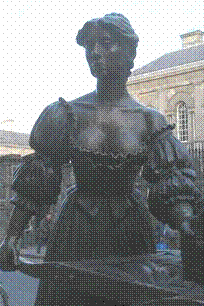|
The Strange Legend of Molly MaloneMolly Malone, Dublin's most famous fishmonger, is a chaste maiden to some and "the tart with the cart" to others
She’s certainly one of the strangest icons ever commemorated officially by a city government. The statue of her on lower Grafton Street, erected in 1987, depicts a woman in a 17th century dress that shows so much cleavage Madonna might be unwilling to wear it. The old song about her, “Cockles and Mussels,” is a sort of unofficial anthem of Dublin, sung regularly by fans at soccer and hurling matches. How this young woman who allegedly sold fish by day, sold her body by night and died young of an undefined fever is a long and twisted tale indeed. Ms. Malone does have some fans who claim she was never a prostitute. Even they, however, claim that the sculptural depiction of her makes sense, because so many women nursed babies in public in her era that the site of a woman’s breasts was quite ordinary. The records of her birth and death have been “discovered” numerous times. However, there are an unlimited number of Molly Malones born in Dublin who could be mistaken for her. Though she lived in the 1600’s the song “Cockles and Mussels” about her does not appear in any historic record before the 1880’s. The now familiar lyric goes: The song goes on to describe how she was a fishmonger like her parents who died young of a fever, and then went on to haunt Dublin’s streets by night. Legend says that in life, she spent some evenings dressed in fishnet stockings, seducing students from Trinity College, a place widely known for its debauchery. Whether her death resulted from Typhoid fever or some other malady is unclear. The year 1988, when Dublin is celebrating its millennium, was a great year for Molly fans. Mysteriously, city fathers decided it would be a good idea to erect a statue of Ms. Malone, although the small graveyard where she was said to be buried was in the process of being bulldozed to make way for a new building. (leaving bones strewn on the street at one point). In the months leading up to the unveiling of the statue, its supporters apparently worked overtime to tidy up the legend around Molly, decided that she lived in the seventeenth century, even though numerous depictions of her on old song sheets show her in 19th century dress. The promotion of her legend was so effective that in 1999, there were numerous calls to have an official celebration of the 300th anniversary of her death. Whether she was real or not, the lady considered to be a chaste laborer by some and the “tart with a cart” by others is certainly a presence in the modern world. A quick search of her name on Google shows that there are over 13,000 websites that mention her in some way. For the happy tourist, there’s no need to worry about issues like authenticity. Before your next Guinness in Dublin, stop by Molly’s statue on Grafton Street for one of the sexier, and silliest, photo-ops in Europe.
|
 Everyone agrees that Molly Malone is one of the more famous people in the history of Dublin. Whether she’s a person who ever really existed is another question.
Everyone agrees that Molly Malone is one of the more famous people in the history of Dublin. Whether she’s a person who ever really existed is another question.